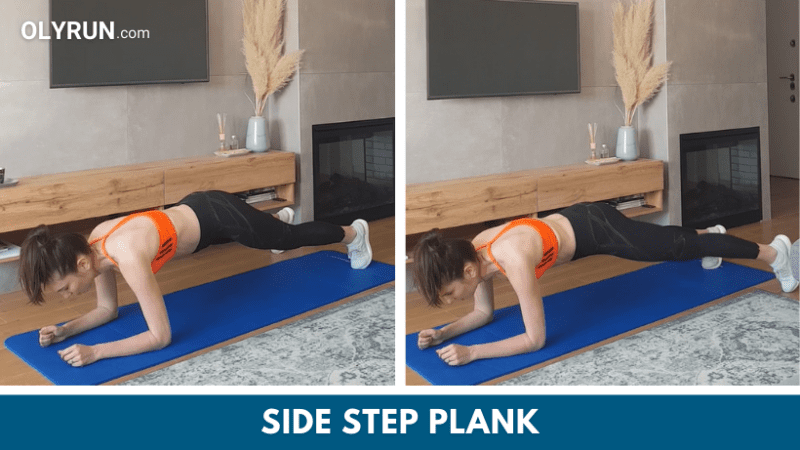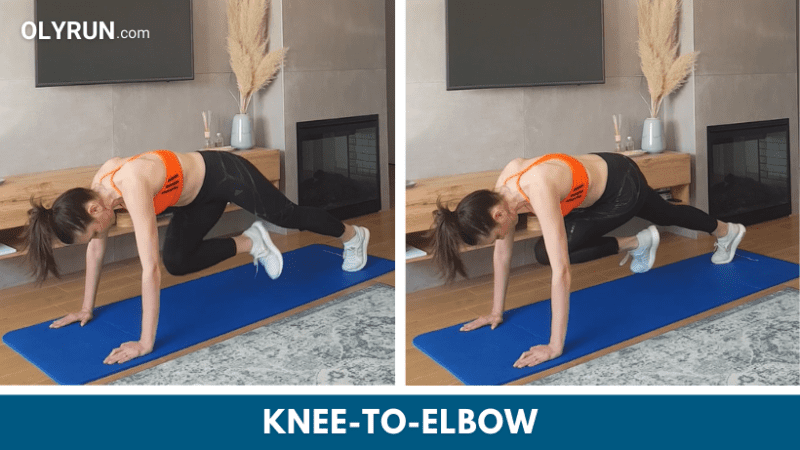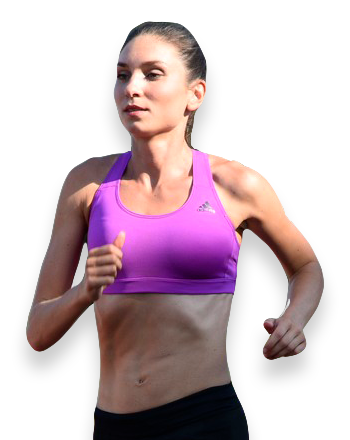Best At-Home Strength Workout for Runners (Top 7 Exercises)
Do you want to do strength training, but lack inspiration?
In this article, I will show you a simple strength workout for runners that you can include in your training plan and do at home.
At-home strength workout for runners
Regardless of whether your goal is to run faster, improve endurance, prevent injury, or improve overall health, strength training should be an integral part of your training plan.
Through strength exercises, we correct muscle imbalances and improve muscle activation, reducing the risk of injury.
Research has shown that the risk of injury is decreased by up to 50%.
Required equipment
For this workout, you will need a stopwatch a timer, and an exercise mat. If you want to make the workout more difficult, you will also need weights.
Exercise overview
- Up & down plank
- Side step plank
- Knee-to-elbow
- Knees-to-chest
- Russian twist
- Reverse lunge jump
- Squat jump
Instructions on how to perform exercises
- Before starting your workout, do a warm-up routine for at least 5 to 10 minutes. This should include dynamic stretching and mobility exercises.
- Perform each exercise for 30 to 45 seconds, resting for 15 seconds between each exercise.
- If you aren’t able to do an exercise properly, shorten the length of the exercise and increase the length of recovery.
- After you finish all seven exercises, rest for 1 minute between sets. After that, repeat the whole set.
- If you are a beginner, do one or two sets. If you are more experienced, then do three or four sets.
- Each exercise is described below, showing how they are performed and what you have to take care of while doing them.

1. Up & down plank

This exercise activates your core, glutes, shoulders, and arms.
How to properly do up & down plank?
- Start in a high plank position with arms perpendicular to the floor. Arms and legs are shoulder-width apart.
- Bend your left arm at the elbow and lower your forearm to the floor, resting on the palm of your right hand.
- Bend your right arm at the elbow and lower your forearm to the floor, resting on the elbow of your left arm.
- Extend your left arm at the elbow, resting on the elbow of your right arm.
- Extend your right arm at the elbow, resting on the palm of your left hand.
- Repeat the movement until the end of the exercise.
Advice for doing up & down plank
- Check your posture – activate your core; hold your head, neck, and spine in a line; look straight down.
- Focus on breathing – it is important to breathe during the whole exercise to ensure proper oxygen flow.
- Check your form – don’t move too fast so that you can focus on the proper way of performing the exercise.
2. Side step plank

This exercise activates your core, glutes, shoulders, and arms.
How to properly do a side step plank?
- Start in a plank position.
- Step to the side with your left foot.
- Return to the starting plank position.
- Repeat the same movement with your right foot.
- Continue switching sides until the end of the exercise.
Advice for doing side step plank
- Check your posture – activate your core; hold your head, neck, and spine in a line; look straight down.
- Focus on breathing – it is important to breathe during the whole exercise to ensure proper oxygen flow.
- Check your form – don’t move too fast so that you can focus on the proper way of performing the exercise.
3. Knee-to-elbow

This exercise activates your core, hip flexors, glutes, shoulders, arms, and calf muscles.
How to properly do the knee-to-elbow exercise?
- Start in a high plank position with arms perpendicular to the floor. Arms and legs are shoulder-width apart.
- Pull the knee of your right leg to the elbow of your left arm.
- Return to the starting plank position.
- Repeat the same movement with your left leg.
- Continue switching sides until the end of the exercise.
Advice for doing the knee-to-elbow exercise
- Check your posture – activate your core; hold your head, neck, and spine in a line; look straight down.
- Focus on breathing – it is important to breathe during the whole exercise to ensure proper oxygen flow.
- Check your form – don’t move too fast so that you can focus on the proper way of performing the exercise.
4. Knees-to-chest

This exercise activates your core and hip flexors.
How to properly do the knees-to-chest exercise?
- Lie on your back in the starting position, with your arms at your sides and legs outstretched.
- Pull both knees to your chest.
- Extend your legs without touching the floor.
- Repeat the same movement until the end of the exercise.
Advice for doing the knees-to-chest exercise
- For an easier version of this exercise, extend your legs and touch the floor, doing the exercise slowly.
- Focus on breathing – it is important to breathe during the whole exercise to ensure proper oxygen flow.
- Maintain balance with your arms.
- Check your form – don’t move too fast so that you can focus on the proper way of performing the exercise.
5. Russian twist

This exercise activates your core and hip flexors.
How to properly do Russian twist?
- Sit in the starting position so that your knees are bent at a 90-degree angle, slightly lean backward, cross your legs, and lift them off the floor so that your upper body and legs form the letter V.
- Rotate your upper body as far to the left as possible.
- Return to the starting position.
- Rotate your upper body as far to the right as possible.
- Continue switching sides until the end of the exercise.
Advice for doing Russian twist
- For an easier version of this exercise, put your feet on the floor. This will, however, make your abs less engaged.
- For a harder version, take a dumbbell – choose a weight with which you will be able to maintain proper form.
- Check your posture – your spine should be as straight as possible, do not bend it, and let your gaze follow the movement of your arms.
- Focus on breathing – it is important to breathe during the whole exercise to ensure proper oxygen flow.
6. Reverse lunge jump

This exercise activates your glutes, quadriceps, hamstrings, hip flexors, core, and calf muscles.
How to properly do a reverse lunge jump?
- Start in a lunge position, look straight ahead, and keep your upper body straight.
- Jump while lifting your left knee into the air, reflecting yourself with the right leg.
- Land on the right foot and return to the starting position.
- Repeat the movement until the end of the exercise.
- Repeat the exercise on the opposite side.
Advice for doing reverse lunge jump
- Check your posture – keep your body straight, and don’t bend or twist your upper body.
- For an easier version of this exercise, just do the basic lunge, without jumping.
- Land softly to lower the pressure on your joints.
- Focus on breathing – it is important to breathe during the whole exercise to ensure proper oxygen flow.
7. Squat jump

This exercise activates your glutes, quadriceps, hamstrings, hip flexors, core, and calf muscles.
How to properly do a squat jump?
- Stand in the starting position so that your feet are hip-width apart, look straight ahead, and hold your upper body straight.
- Get into a half-squat position so that your thighs are parallel to the floor.
- Swing your arms and jump as high as you can.
- Land back in the starting position.
- Repeat the movement until the end of the exercise.
Advice for doing a squat jump
- Check your posture – keep your body straight, and don’t bend or twist your upper body.
- Land softly to lower the pressure on your joints.
- Focus on breathing – it is important to breathe during the whole exercise to ensure proper oxygen flow.
Tip
Pin this post so you can do this workout again (or later)!
Should long-distance runners do strength training?
Long-distance runners should do strength training for a number of reasons.
Strength exercises correct the muscle imbalance and improve muscle activation, reducing the risk of injury. Research has shown that the risk of injury is reduced by up to 50%.
Strength exercises improve running technique and make you run more efficiently. In other words, at the same cost of energy, you will run longer and faster.
Research has shown that strength training improves your running economy by 2-8% and the overall race result (1.5–10km) by 2-5%.
Through strength exercises, you improve your neuromuscular efficiency, and communication between nerves and muscles, accelerating nerve impulses that send signals to muscle fibers.
That way, your muscles become better coordinated for an intense workout or a race.
Read more: Strength Training for Runners (Top 19 Workout Exercises)

Matea Matošević
Hi, I’m Matea! I’m an Olympic Marathon Runner, founder, and writer behind OLYRUN.com. On this site, I provide help in the form of my knowledge and experience to all who love running and active living. Read more…

